Quantifying the Effects of Near-Bed Concentration on the Sediment Flux after the Operation of the Three Gorges Dam, Yangtze River
Abstract
:1. Introduction
2. Materials and Methods
2.1. Study Area and Data
2.2. Equations to Estimate the Effects of Near-Bed Concentration on Sediment Flux
3. Results
3.1. Distinct Non-Uniform Vertical Distribution
3.1.1. Comparing with Vertical-Averaged Concentration
3.1.2. Comparing with Near-Bed Point
3.2. Effects on Sediment Flux
3.2.1. Vertical Sediment Flux
3.2.2. Sectional Sediment Flux
4. Discussion
4.1. Comparing with Data Measured Before Dam Operation
4.1.1. Vertical Profiles of SSC
4.1.2. Sediment Flux
4.2. Contribution of Large Floods
4.3. Connection with Dongting Lake
4.4. Uncertainties
5. Conclusions
- (1)
- In sub-saturated channels, vertical distribution of suspended sediment concentration (SSC) is characterized by a remarkably large concentration in the near-bed zone (within 10% of water depth from the river-bed). The maximum measured concentration may be up to 15 times of vertical average concentration, while the ratio in quasi-equilibrium channels is less than four.
- (2)
- Concentrations normalized with reference concentration at the same height may decrease with increasing values of suspension index (ω/u*). Additionally, concentration near water surface may be larger than concentration in near-bed region when suspension index is smaller than 0.01.
- (3)
- After the dam operation, ignoring the near-bed concentration may cause up to 35% deviation when applied to estimate the sediment flux in the unsaturated flows. Deviations may increase with increasing discharge in flood season, while the maximum value may occur in non-flood season. Deviations in quasi-equilibrium channel may not increase with increasing discharge in flood season, while the maximum value may also occur in non-flood season. Deviations may increase with increasing particle size and suspension index.
Acknowledgments
Conflicts of Interest
References
- Ludwig, W.; AmiotteSuchet, P.; Probst, J.L. River discharge of carbon to the world’s oceans: Determining local inputs of alkalinity and of dissolved and particulate organic carbon. Comptes Rendus de L Academie des Sciences Serie II Fascicule A-Sciences de la Terre et des Planetes 1996, 323, 1007–1014. [Google Scholar]
- Asselman, N.E.M. Fitting and interpretation of sediment rating curves. J. Hydrol. 2000, 234, 228–248. [Google Scholar] [CrossRef]
- Zuo, S.H.; Li, J.F.; Wan, X.N.; Shen, H.T.; Fu, G. Characteristics of temporal and spatial variation of suspended sediment concentration in the Changjiang Estuary. J. Sediment Res. 2006, 3, 68–75, (In Chinese with English Abstract). [Google Scholar]
- Pal, D.; Ghoshal, K. Hydrodynamic interaction in suspended sediment distribution of open channel turbulent flow. Appl. Math. Modell. 2017, 49, 630–646. [Google Scholar] [CrossRef]
- Higgins, A.; Restrepo, J.C.; Otero, L.J.; Ortiz, J.C.; Conde, M. Vertical distribution of suspended sediment in the mouth area of the Magdalena River, Colombia. Lat. Am. J. Aquat. Res. 2017, 45, 724–736. [Google Scholar] [CrossRef]
- Nir, S.Q.; Sun, H.G.; Zhang, Y.; Chen, D.; Chen, W.; Chen, L.; Schaefer, S. Vertical distribution of suspended sediment under steady flows: Existing theories and fractional derivative model. Discret. Dyn. Nat. Soc. 2017, 2017, 1–11. [Google Scholar]
- Sahin, C.; Verney, R.; Sheremet, A.; Voulgaris, G. Acoustic backscatter by suspended cohesive sediment: Field observations, Seine Estuary, France. Cont. Shelf Res. 2017, 134, 39–51. [Google Scholar] [CrossRef]
- Armijos, E.; Crave, A.; Espinoza, R.; Fraizy, P.; Dos Santos, A.L.M.R.; Sampaio, F.; De Oliveria, E.; Santini, W.; Martinez, J.M.; Autin, P.; et al. Measuring and modelling vertical gradients in suspended sediments in the Solimões/Amazon River. Hydrol. Process. 2017, 31, 654–667. [Google Scholar] [CrossRef]
- He, L.; Chen, D.; Duan, G.L.; Zhu, Z.H.; Zhang, S.Y. Sediment suspension in the “starving” Jingjiang reach, downstream from the Three Gorges Dam, China. In Proceedings of the World Environmental and Water Resources Congress, West Palm Beach, FL, USA, 22–26 May 2016; pp. 303–313. [Google Scholar]
- Fang, H.Y.; Cai, Q.G.; Chen, H.; Li, Q.Y. Temporal changes in suspended sediment transport in a gullied loess basin: The lower Chabagou Creek on the Loess Plateau in China. Earth Surf. Process. Landf. 2008, 33, 1977–1992. [Google Scholar] [CrossRef]
- Zhang, R.; Zhang, S.H.; Xu, W.; Wang, B.D.; Wang, H. Flow regime of the three outlets on the south bank of Jingjiang River, China: An impact assessment of the Three Gorges Reservoir for 2003–2010. Stoch. Environ. Res. Risk Assess. 2015, 29, 2047–2060. [Google Scholar] [CrossRef]
- Fan, P.; Li, J.C.; Liu, Q.Q.; Singh, V.P. Case Study: Influence of morphological changes on flooding in Jingjiang River. J. Hydraul. Eng. 2008, 134, 1757–1766. [Google Scholar] [CrossRef]
- Yang, C.; Cai, X.B.; Wang, X.L.; Yan, R.R.; Zhang, T.; Zhang, Q.; Lu, X.R. Remotely sensed trajectory analysis of channel migration in lower Jingjiang Reach during the period of 1983–2013. Remote Sens. 2015, 7, 16241–16256. [Google Scholar] [CrossRef]
- Gao, B.; Yang, D.W.; Yang, H.B. Impact of the three Gorges Dam on flow regime in the middle and lower Yangtze River. Quat. Int. 2013, 304, 43–50. [Google Scholar] [CrossRef]
- Yang, H.; Tang, R. Study on the Evolution of Jingjiang Reach of Middle Yangtze River; China Water Power Press: Beijing, China, 1999. (In Chinese) [Google Scholar]
- Dai, Z.J.; Fagherazzi, S.; Mei, X.F.; Gao, J.J. Decline in suspended sediment concentration delivered by the Changjiang (Yangtze) River into the East China Sea between 1956 and 2013. Geomorphology 2016, 268, 123–132. [Google Scholar] [CrossRef]
- Xu, K.H.; Milliman, J.D. Seasonal variations of sediment discharge from the Yangtze River before and after impoundment of the Three Gorges Dam. Geomorphology 2009, 104, 276–283. [Google Scholar] [CrossRef]
- Xia, J.Q.; Zong, Q.L.; Deng, S.S.; Xu, Q.X.; Lu, J.Y. Seasonal variations in composite riverbank stability in the Lower Jingjiang Reach, China. J. Hydrol. 2014, 519, 3664–3673. [Google Scholar] [CrossRef]
- Xia, J.Q.; Zong, Q.L.; Zhang, Y.; Xu, Q.X.; Li, X.J. Prediction of recent bank retreat processes at typical sections in the Jingjiang Reach. Sci. China 2014, 57, 1490–1499. [Google Scholar] [CrossRef]
- Zhang, C.F. Vertical Profile of Non-Uniform Suspended Sediment Concentration in Yangtze Estuary. Master’s Thesis, Zhejiang University, Hangzhou, China, 2016. (In Chinese with English Abstract). [Google Scholar]
- Dong, X.T.; Li, R.J.; Fu, G.C.; Zhang, H.C. Relationship between vertical distribution of velocity and sediment concentration of sediment-laden flow. J. Hohai Univ. Natl. Sci. 2015, 43, 371–376, (In Chinese with English Abstract). [Google Scholar]
- Tang, M.L.; Cao, H.Q.; Li, Q.Y.; Zhai, W.L. Vertical distribution of suspended sediment in middle reaches of Yangtze River. Yangtze River 2017, 48, 6–11, (In Chinese with English Abstract). [Google Scholar]
- Feng, Q.; Xiao, Q.L. A new S-type vertical distribution of suspended sediment concentration. J. Sediment Res. 2015, 1, 19–24, (In Chinese with English Abstract). [Google Scholar]
- Xia, Y.F.; Xu, H.; Chen, Z.; Wu, D.W.; Zhang, S.Z. Experimental study on suspended sediment concentration and its vertical distribution under spilling breaking wave actions in silty coast. China Ocean Eng. 2011, 25, 565–575. [Google Scholar] [CrossRef]
- JHWRSB (Jingjiang Hydrology & Water Resources Surveying Bureau, Hydrology Bureau). Technical Report: Observation of Unbalanced Sediment Transport in the Lower Reaches of the Three Gorges Reservoir; Changjiang Water Resources Commission: Wuhan, Hubei, China, 2016. (In Chinese) [Google Scholar]
- Yuan, Y.; Zhang, X.F.; Duan, G.L. Modifying the channel erosion and deposition amount of Yichang-Jianli reach calculated by sediment discharge method. J. Hydroelectr. Eng. 2014, 33, 163–169, (In Chinese with English Abstract). [Google Scholar]
- Duan, G.L.; Peng, Y.B.; Guo, M.J. Comparative analysis on riverbed erosion and deposition amount calculated by different methods. J. Yangtze River Sci. Res. Inst. 2014, 31, 108–118, (In Chinese with English Abstract). [Google Scholar]
- Dai, S.B.; Lu, X.X. Sediment load change in the Yangtze River (Changjiang): A review. Geomorphology 2014, 215, 60–70. [Google Scholar] [CrossRef]
- Zhao, G.S.; Lu, J.Y.; Visser, P.J. Fluvial river regime in disturbed river systems: A case study of evolution of the Middle Yangtze River in post-TGD (Three Gorges Dam), China. J. Geol. Geophys. 2015, 4, 6. [Google Scholar] [CrossRef]
- Zhang, X.F.; Tan, G.M. Characteristics of vertical concentration distribution of non-uniform particles. J. Hydraul. Eng. 1992, 10, 48–52, (In Chinese with English Abstract). [Google Scholar]
- Lenzi, M.A.; Mao, L.; Comiti, F. Interannual variation of suspended sediment load and sediment yield in an alpine catchment. Hydrol. Sci. J. 2003, 48, 899–915. [Google Scholar] [CrossRef]
- Zabaleta, A.; Martinez, M.; Uriarte, J.A.; Antiguedad, I. Factors controlling suspended sediment yield during runoff events in small headwater catchments of the Basque Country. Catena 2007, 71, 179–190. [Google Scholar] [CrossRef]
- Langlois, J.L.; Johnson, D.W.; Mehuys, G.R. Suspended sediment dynamics associated with snowmelt runoff in a small mountain stream of Lake Tahoe (Nevada). Hydrol. Process. 2005, 19, 3569–3580. [Google Scholar] [CrossRef]
- Tena, T.; Batalla, R.J.; Vericat, D. Reach-scale suspended sediment balance downstream from dams in a large Mediterranean River. Hydrol. Sci. J. 2012, 57, 831–849. [Google Scholar] [CrossRef]
- Zhang, W.; Yuan, J.; Han, J.Q.; Huang, C.T.; Li, M. Impact of the Three Gorges Dam on sediment deposition and erosion in the middle Yangtze River: A case study of the Shashi Reach. Hydrol. Res. 2016, 175–186. [Google Scholar] [CrossRef]
- Whitaker, A.C.; Sato, H.; Sugiyama, H. Changing suspended sediment dynamics due to extreme flood events in a small pluvial-nival system in northern Japan. In Sediment Dynamics in Changing Environments; IAHS-AISH Publication: Christchurch, New Zealand, 2008; Volume 325, pp. 192–199. [Google Scholar]
- Li, L.Q.; Lu, X.X.; Chen, Z.Y. River channel change during the last 50 years in the middle Yangtze River, the Jianli reach. Geomorphology 2007, 85, 185–196. [Google Scholar] [CrossRef]
- Zhu, Y.H.; Fan, B.L.; Yao, S.M.; Sun, G.Z.; Li, F.Z. Propagation features of the 1998 big floods in the Jinagjiang Reach of the Yangtze River. In Advances in Water Resources and Hydraulic Engineering; Springer: Berlin/Heidelberg, Germany, 2009; pp. 1032–1037. [Google Scholar]
- Zong, Y.Q.; Chen, X.Q. The 1998 flood on the Yangtze, China. Nat. Hazards 2000, 22, 165–184. [Google Scholar] [CrossRef]
- Xu, K.Q.; Chen, Z.Y.; Zhao, Y.W.; Wang, Z.H.; Zhang, J.Q.; Hayashi, S.J.; Murakami, S.; Watanabe, M. Simulated sediment flux during 1998 big-flood of the Yangtze (Changjiang) River, China. J. Hydrol. 2005, 313, 221–223. [Google Scholar] [CrossRef]
- Zhou, W.H.; Chen, Y.H. The 1998 flood of the Yangtze River. Int. J. Sediment Res. 1999, 14, 61–66. [Google Scholar]
- Seeger, M.; Errea, M.-P.; Begueria, S.; Arnaez, J.; Marti, C.; Garcia-Ruiz, J.M. Catchment soil moisture and rainfall characteristics as determinant factors for discharge/suspended sediment hysteretic loops in a small headwater catchment in the Spanish Pyrenees. J. Hydrol. 2004, 288, 299–311. [Google Scholar] [CrossRef] [Green Version]
- Ran, L.; Lu, X.; Xin, Z.; Yang, X. Cumulative sediment trapping by reservoirs in large river basins: A case study of the Yellow River basin. Glob. Planet. Chang. 2013, 100, 308–319. [Google Scholar] [CrossRef]
- Xia, J.Q.; Deng, S.S.; Lu, J.Y.; Xu, Q.X.; Zong, Q.L.; Tan, G.M. Dynamic channel adjustments in the Jingjiang reach of the middle Yangtze River. Sci. Rep. 2016, 6, 22802. [Google Scholar] [CrossRef] [PubMed]
- Dou, H.; Jiang, J. Dongting Lake; Press of University of Science and Technology of China: Hefei, China, 2000. [Google Scholar]
- Li, N.; Wang, L.C.; Zeng, C.F.; Wang, D.; Liu, D.F.; Wu, X.T. Variations of runoff and sediment load in the Middle and Lower Reaches of the Yangtze River, China (1950–2013). PLoS ONE 2016, 11, e160154. [Google Scholar] [CrossRef] [PubMed]
- Orwin, J.F.; Smart, C.C. An inexpensive turbidimeter for monitoring suspended sediment. Geomorphology 2005, 68, 3–15. [Google Scholar] [CrossRef]
- Pfannkuche, J.; Schmidt, A. Determination of suspended particulate matter concentration from turbidity measurements: Particle size effects and calibration procedures. Hydrol. Process. 2003, 17, 1951–1963. [Google Scholar] [CrossRef]
- Stutter, M.; Dawson, J.J.C.; Glendell, M.; Napier, F.; Potts, J.M.; Sample, J.; Vinten, A.; Watson, H. Evaluating the use of in-situ turbidity measurements to quantify fluvial sediment and phosphorus concentration and flux in agricultural streams. Sci. Total Environ. 2017, 607–608, 391–402. [Google Scholar] [CrossRef] [PubMed]
- Pagliari, D.; Rossi, L.; Passoni, D.; Pinto, L.; De Michele, C.; Avanzi, F. Measuring the volume of flushed sediments in a reservoir using multi-temporal images acquired with UAS. Geomat. Nat. Hazards Risk 2017, 8, 150–166. [Google Scholar] [CrossRef]
- Bandini, F.; Jakobsen, J.; Olesen, D.; Reyna-Gutierrez, J.A.; Bauer-Gottwein, P. Measuring water level in rivers and lakes from lightweight unmanned aerial vehicles. J. Hydrol. 2017, 548, 237–250. [Google Scholar] [CrossRef]
- Togneri, M.; Lewis, M.; Neill, S.; Masters, I. Comparison of ADCP observations and 3D model simulations of turbulence at a tidal energy site. Renew. Energy 2017, 114, 273–282. [Google Scholar] [CrossRef]
- Kasvi, E.; Hooke, J.; Kurkela, M.; Vaaja, M.T.; Virtanen, J.P.; Hyyppa, H.; Alho, P. Modern empirical and modelling study approaches in fluvial geomorphology to elucidate sub-bend-scale meander dynamics. Prog. Phys. Geogr. 2017, 41, 533–569. [Google Scholar] [CrossRef]
- Zhang, Q.; Shi, Y.F.; Xiong, M. Geometric properties of river cross sections and associated hydrodynamic implications in Wuhan-Jiujiang river reach, the Yangtze River. J. Geogr. Sci. 2009, 19, 58–66. [Google Scholar] [CrossRef]
- Li, W.K.; Wu, Y.X.; Huang, Z.M.; Fan, R.; Lv, J.F. Measurement results comparison between Laser Particle Analyzer and Sieving method in particle size distribution. Zhongguo Fenti Jishu 2007, 5, 10–13, (In Chinese with English Abstract). [Google Scholar]
- Jin, W.F.; Liang, C.J.; Zhou, B.F.; Li, J.D. Measurement and analysis of high suspended sediment concentration in Jintang channel with vessel-mounted ADCP. J. Mar. Sci. 2009, 27, 31–39, (In Chinese with English Abstract). [Google Scholar]
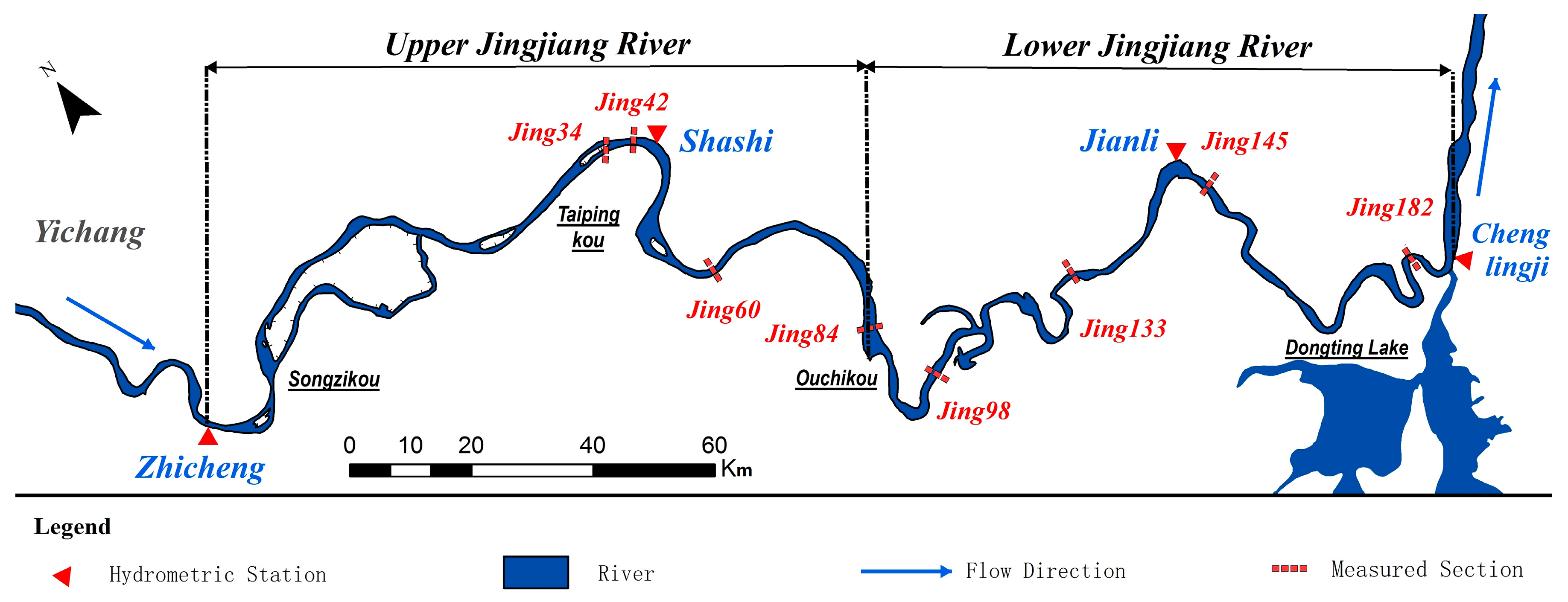
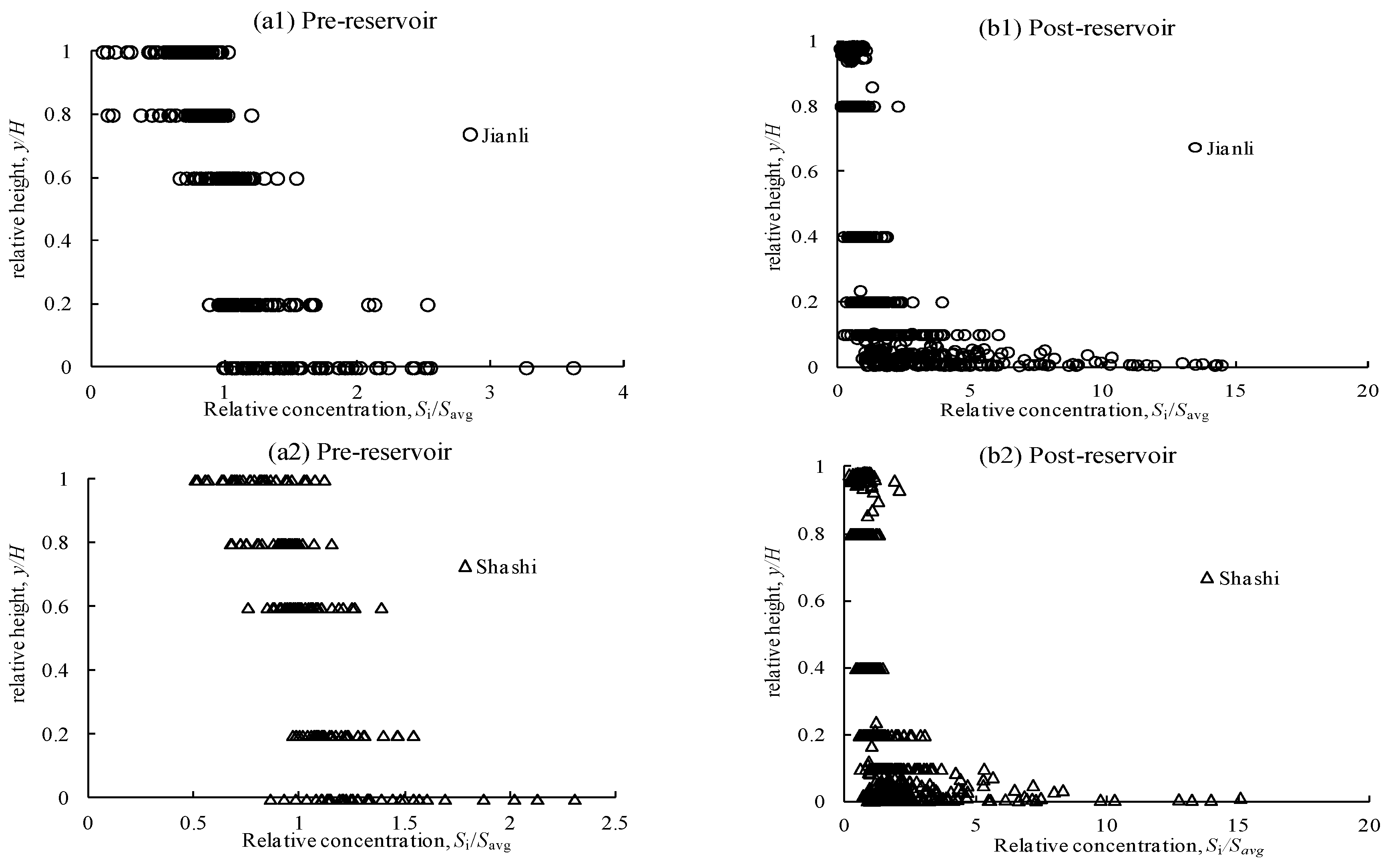
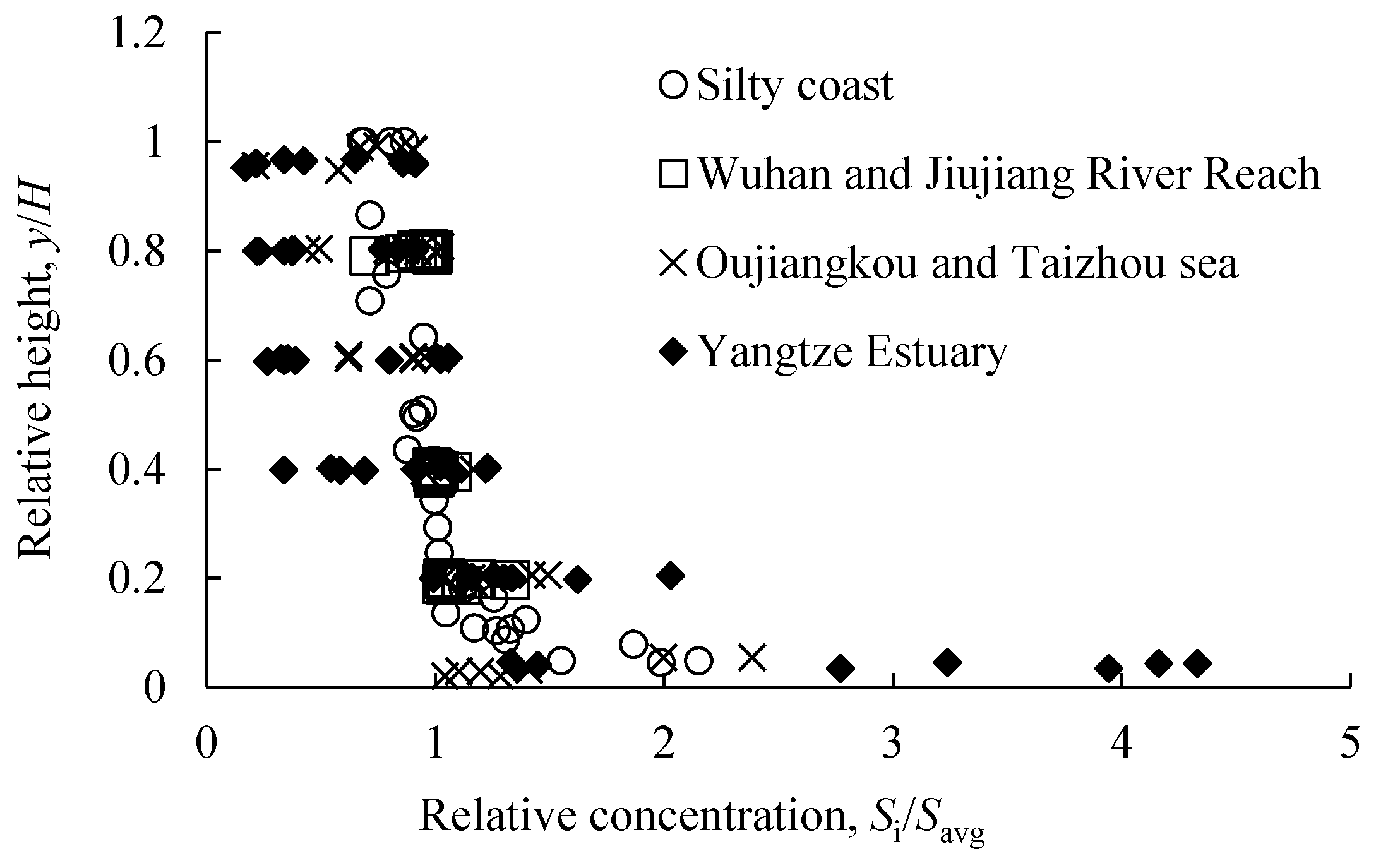
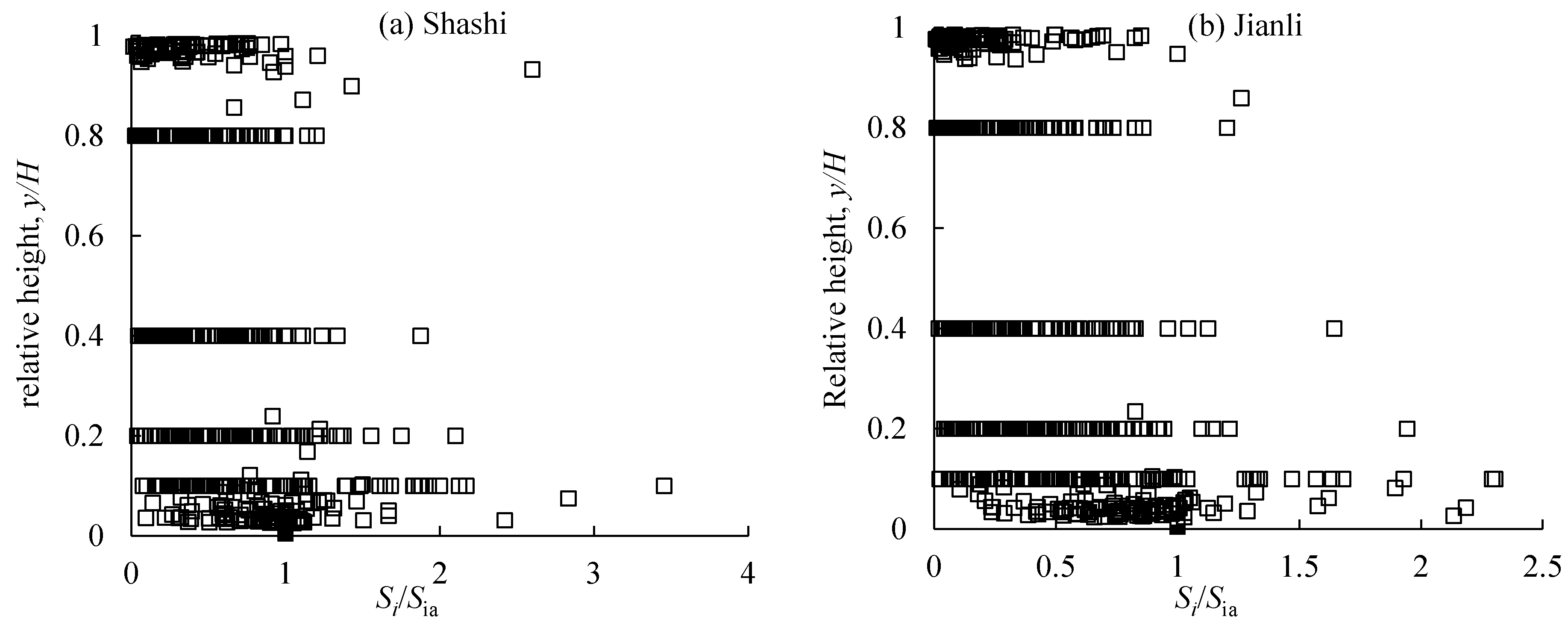


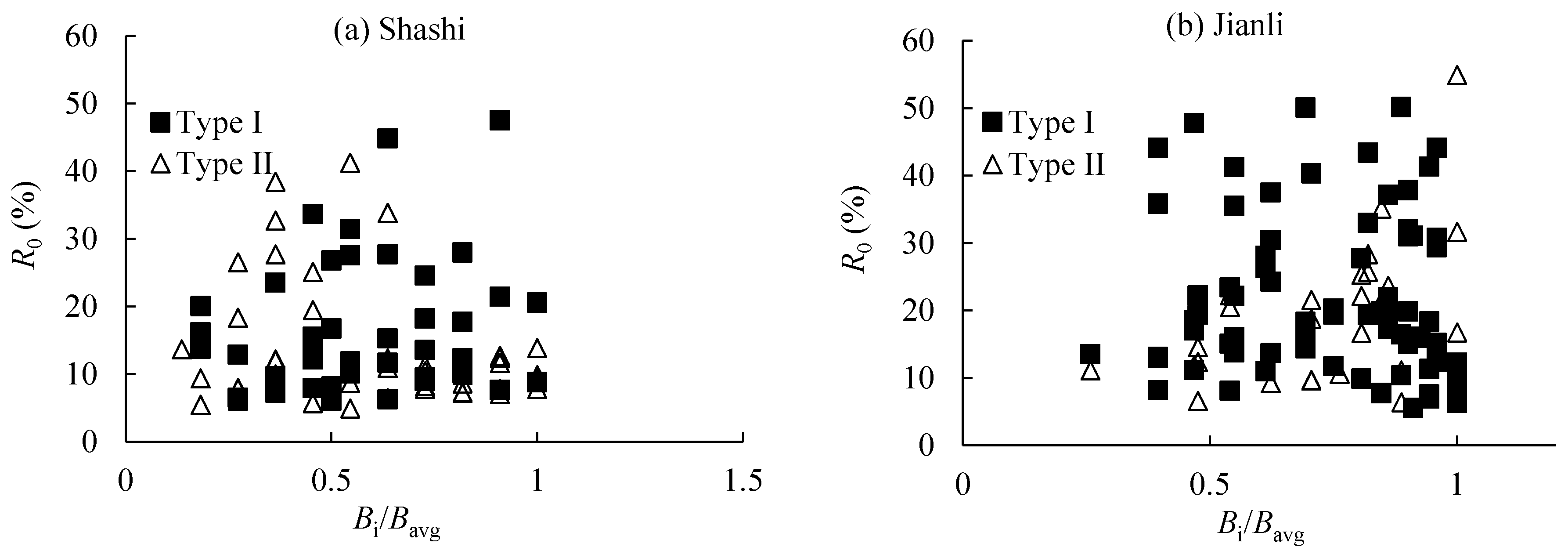
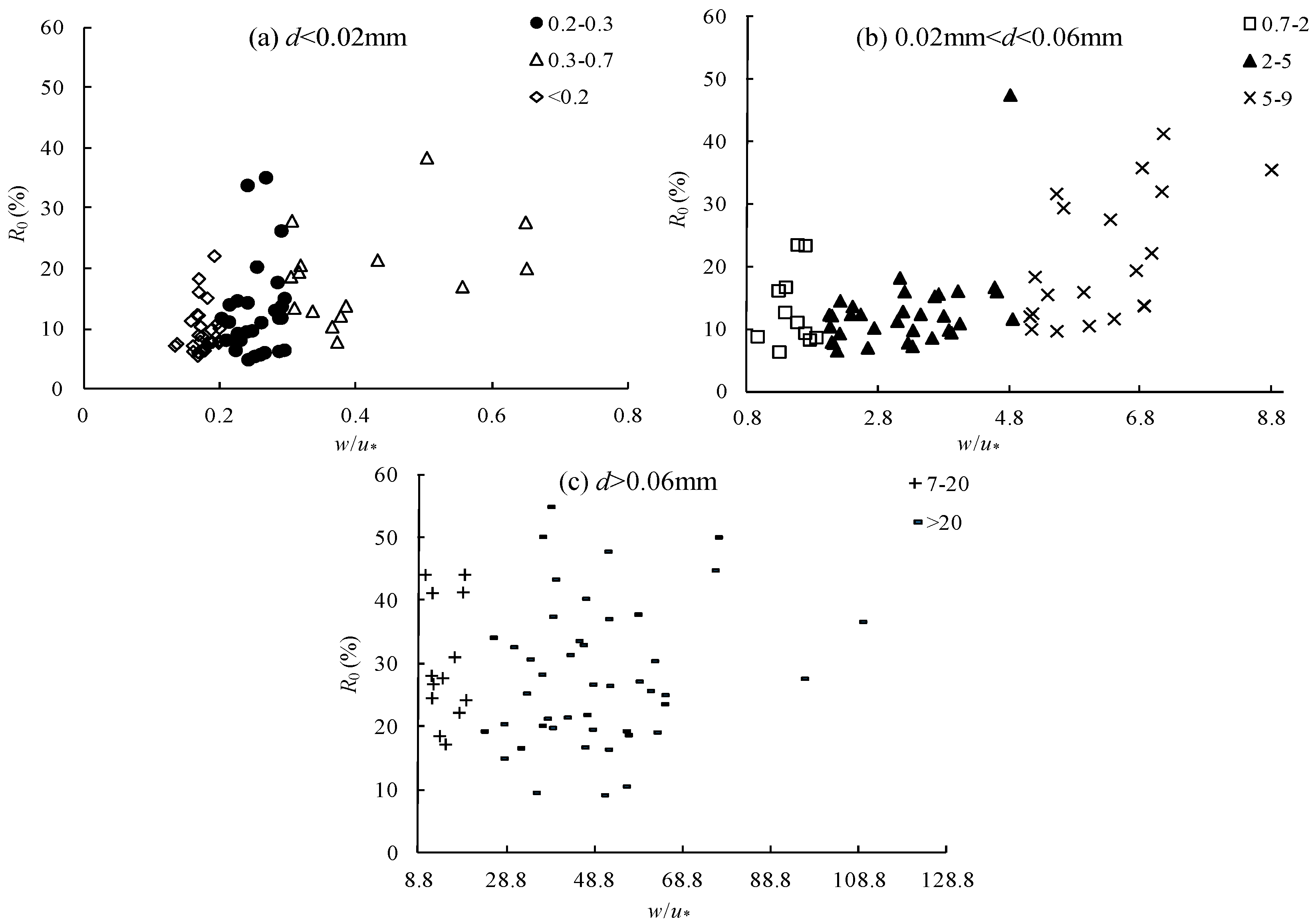
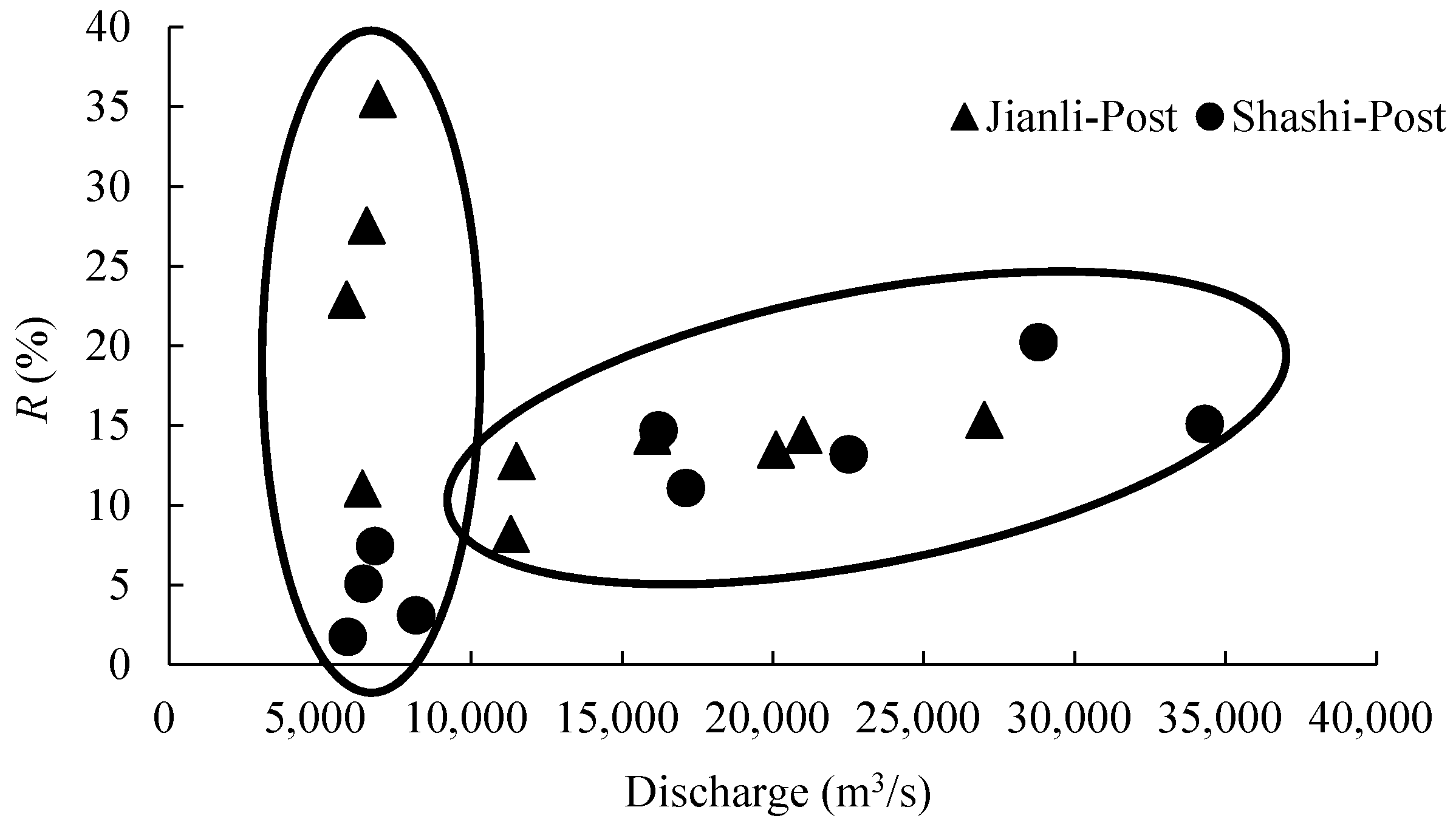
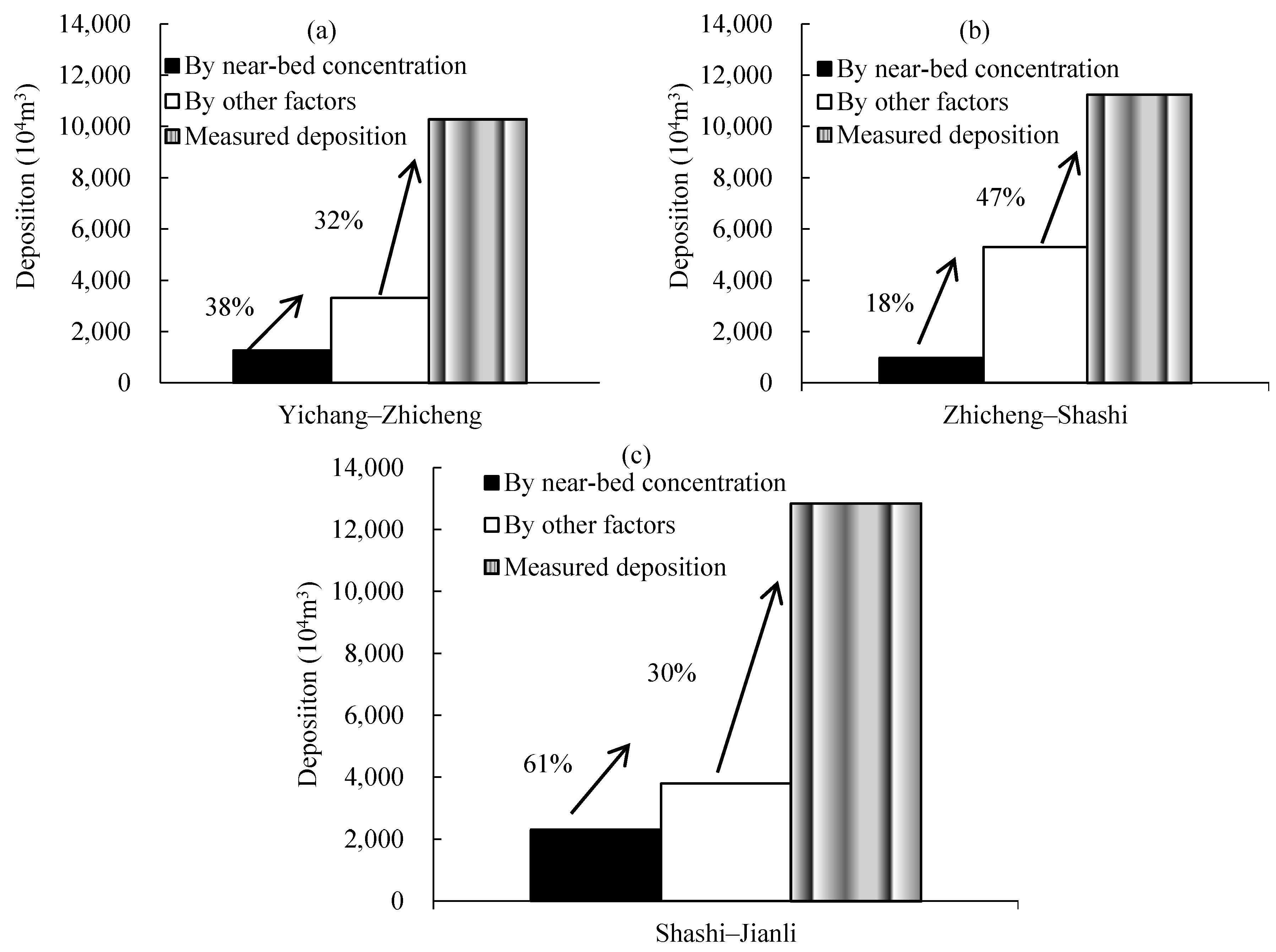
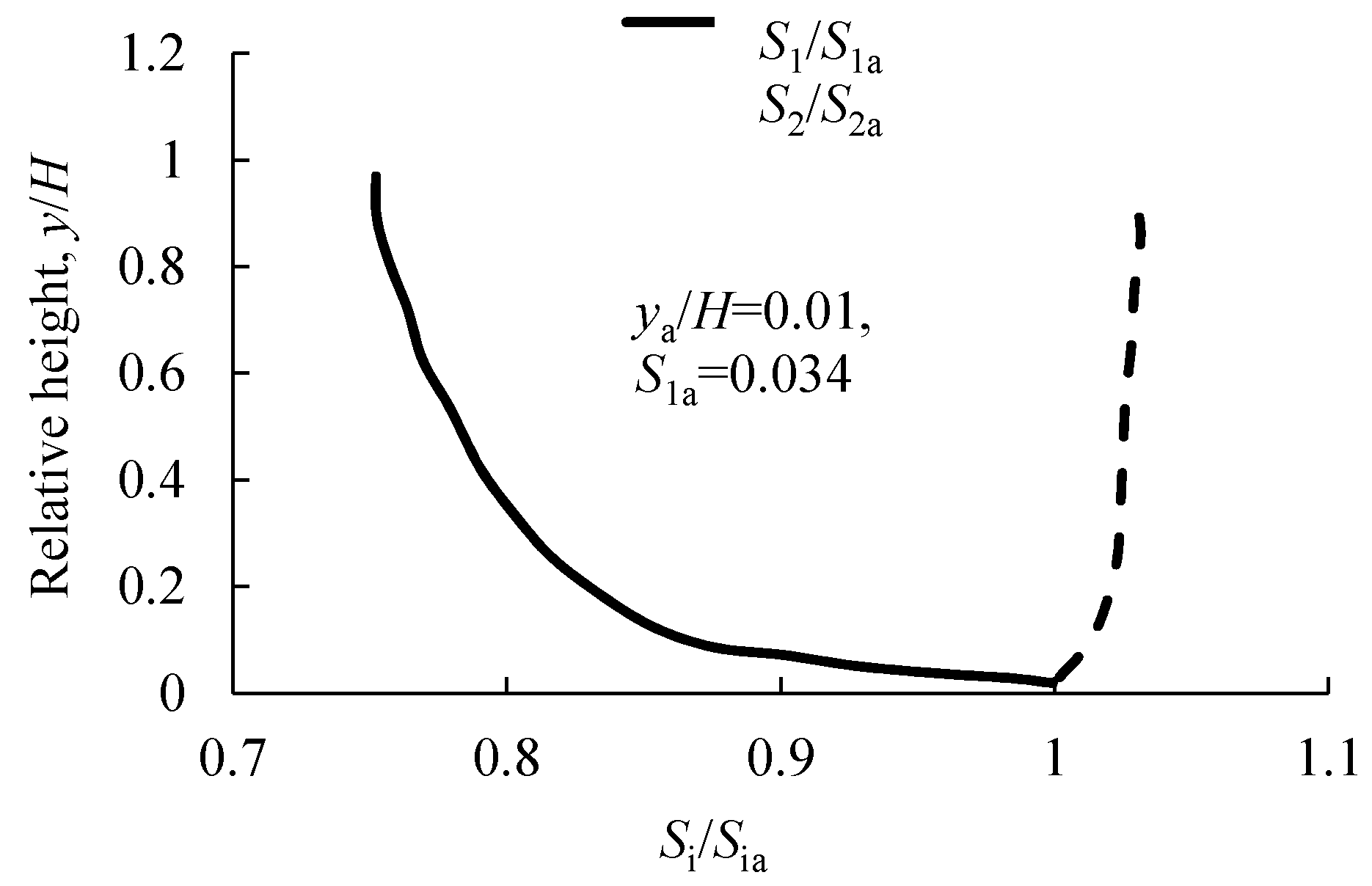


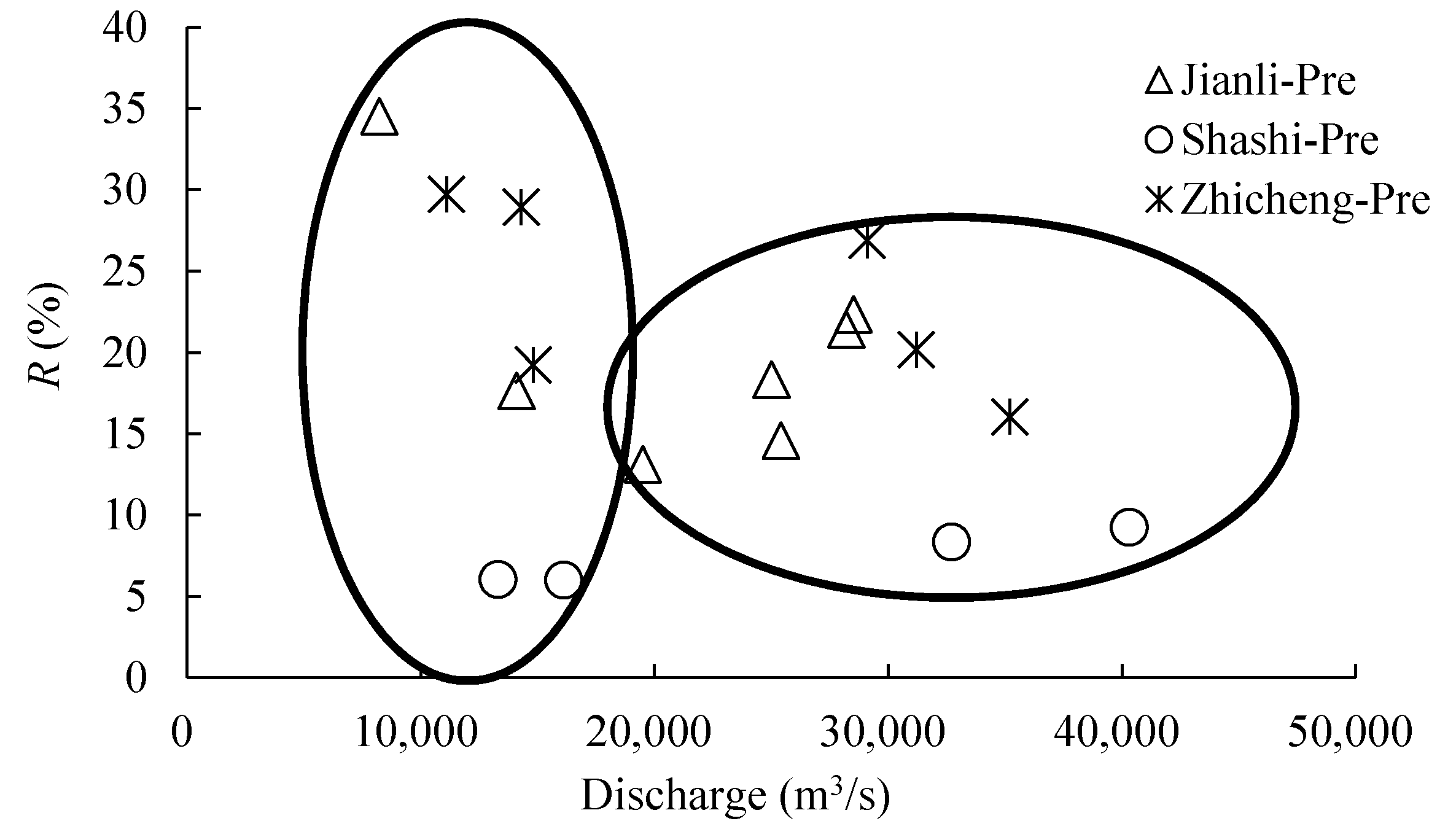
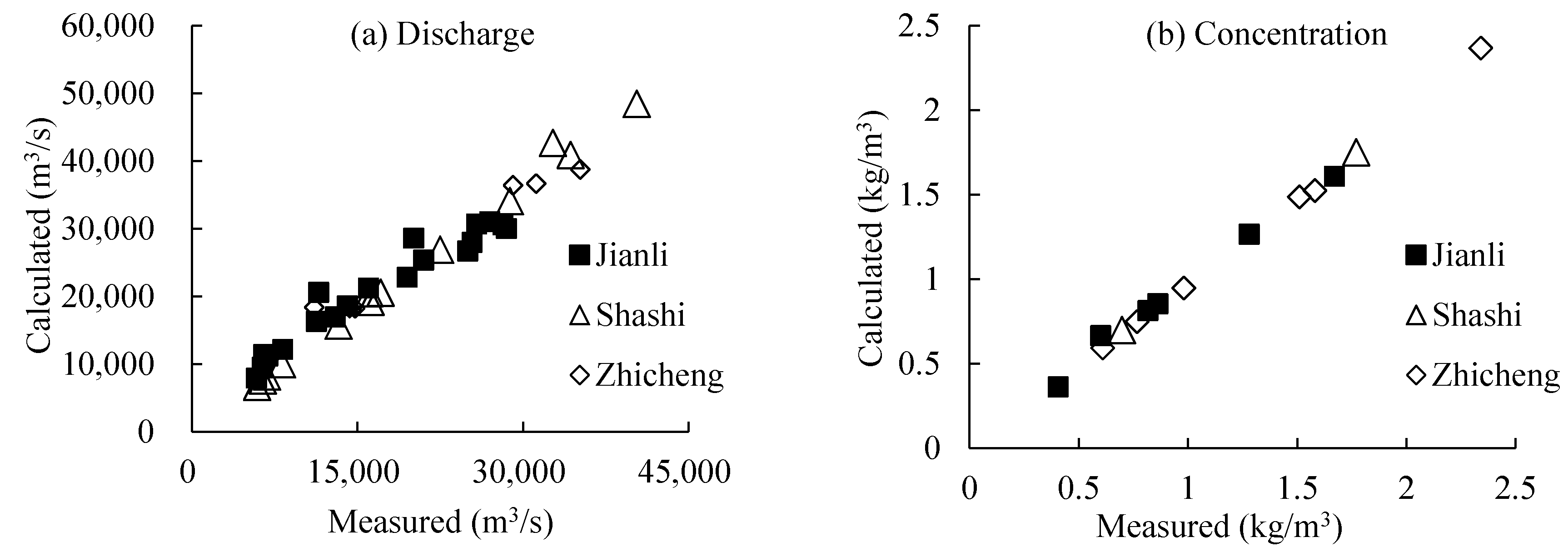
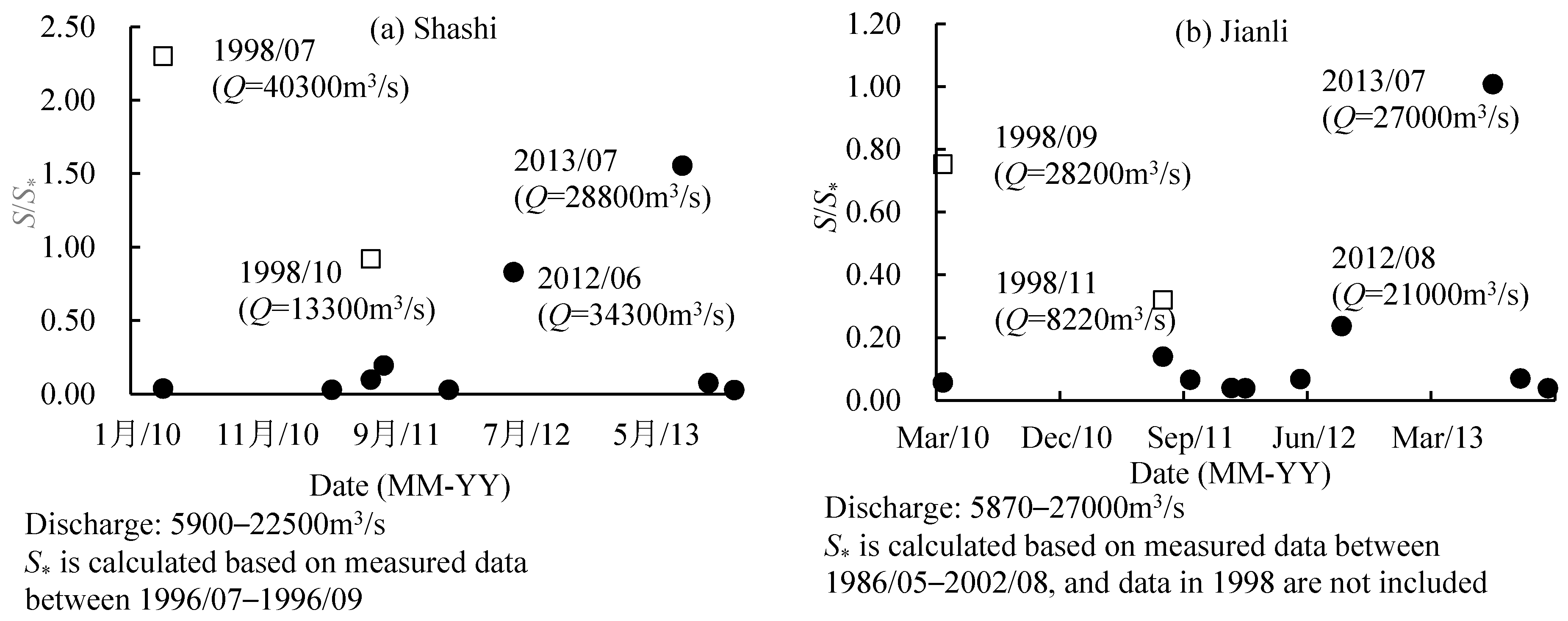
| Stations | Measured Year | Groups |
|---|---|---|
| Zhicheng | 1996, 1998, 2002 | 55 |
| Shashi | 1996, 1998, 2010, 2011, 2012, 2013 | 130 |
| Jianli | 1986, 1998, 2002, 2010, 2011, 2012, 2013 | 180 |
| Stations | Type I | Type II | ||||||||||
|---|---|---|---|---|---|---|---|---|---|---|---|---|
| Flood Season | Non-Flood Season | Flood Season | Non-Flood Season | |||||||||
| Amount of Group | Range of (ω/u*) | D50 (mm) | Amount of Group | Range of (ω/u*) | D50 (mm) | Amount of Group | Range of (ω/u*) | D50 (mm) | Amount of Group | Range of (ω/u*) | D50 (mm) | |
| Shashi | 33 | 0.16–95.38 | 0.01 | 17 | 2.09–108.89 | 0.06 | 20 | 0.16–1.37 | 0.03 | 25 | 1.84–95.67 | 0.07 |
| Jianli | 47 | 0.14–76.15 | 0.06 | 29 | 2.38–61.64 | 0.10 | 10 | 0.13–32.58 | 0.06 | 19 | 1.38–63.92 | 0.10 |
| Stations | Type I | Type II | ||
|---|---|---|---|---|
| Flood Season | Non-Flood Season | Flood Season | Non-Flood Season | |
| Shashi | 15.67 | 21.28 | 12.51 | 14.10 |
| Jianli | 19.57 | 27.70 | 16.94 | 19.61 |
| Stations | Total | Flood Season | Non-Flood Season |
|---|---|---|---|
| Shashi | 10.21 | 14.88 | 4.36 |
| Jianli | 17.56 | 13.10 | 24.24 |
| Stations | Flood Season | Non-Flood Season | ||
|---|---|---|---|---|
| Amount of Group | Range of (ω/u*) | Amount of Group | Range of (ω/u*) | |
| Shashi | 27 | 0.08–0.46 | 9 | 0.23–1.34 |
| Jianli | 53 | 0.02–0.78 | 22 | 0.05–12.12 |
| Stations | Total | Flood Season | Non-Flood Season |
|---|---|---|---|
| Zhicheng | 23.50 | 21.04 | 25.86 |
| Shashi | 7.43 | 8.81 | 6.04 |
| Jianli | 32.95 | 17.96 | 45.93 |
| Stations | Flood Volumes 109 m3 | Maximum Peak Flow Discharge | Maximum Flood Stage | |||
|---|---|---|---|---|---|---|
| In 30 Days | In 60 Days | Discharge (m3/s) | Date | Stage (m) | Date | |
| Yichang | 137.9 | 254.5 | 63,600 | 16/8 | 54.49 | 16/8 |
| Shashi | – | – | 53,700 | 17/8 | 45.22 | 17/8 |
| Jianli | – | – | 45,200 | 17/8 | 38.31 | 17/8 |
| Luoshan | – | – | 68,600 | 27/7 | 34.95 | 20/8 |
| Hankou | 175.4 | 336.5 | 72,300 | 19/8–20/8 | 29.43 | 20/8 |
| Jiujiang | – | – | – | – | 23.03 | 2/8 |
| Datong | 202.7 | 395.1 | 82,300 | – | 16.32 | 2/8 |
| Nanjing | – | – | – | – | 10.14 | 29/7 |
| Measuring | Instruments or Methods | Criteria or Error |
|---|---|---|
| Positioning of instrument | Total station Digital Level | Positioning error: ±0.3 m (vertical), ±1.5 m (vertical lines) |
| Vertical lines for measuring velocity | RTK–GNSS (antenna and receiver) | Position errors of antenna: 0.5° RMS (orientation) and 0.5–3 m RMS (position). Position errors of receiver: ±10 mm + 1 ppm (horizontal), ±20 mm + 1 ppm (vertical), where ppm means additional error per km of baseline. |
| Velocity | Acoustic Doppler Current Profilers (ADCP) | The deviation between each measured discharge and the averaged discharge should be less than ±5%, otherwise, data should be re-measured. |
| Water depth | ADCP | Verified with fish lead. Frequency: 600 KHz Sounding range: 0.7–75 m Velocity measurement: ±20 m/s Resolution: 0.1 cm/s |
| Sampling Suspended sediment | Bottom-touched automatic-closing sampler | The dropping speed of the sampler is reduced when approaching the riverbed. The sampler may close automatically when it is brought into contact with the riverbed. |
| Suspended sediment gradation | Sieving method | Field (2 mm, 5 mm, 10 mm, 25 mm, 50 mm, 75 mm, 100 mm, 150 mm, 200 mm, 250 mm, and 300 mm) Lab (0.002 mm, 0.004 mm, 0.008 mm, 0.016 mm, 0.032 mm, 0.062 mm, 0.125 mm, 0.25 mm, 0.5 mm, 1.0 mm, and 2.0 mm) |
| Near-bed concentration | Double-checked after sampling and grain-size analysis | The measured concentration is reliable when the vertical profiles of concentration of particles with d50 < 0.062 mm has no changing point in near-bed region. Otherwise, related measurements should be omitted. |
© 2017 by the author. Licensee MDPI, Basel, Switzerland. This article is an open access article distributed under the terms and conditions of the Creative Commons Attribution (CC BY) license (http://creativecommons.org/licenses/by/4.0/).
Share and Cite
He, L. Quantifying the Effects of Near-Bed Concentration on the Sediment Flux after the Operation of the Three Gorges Dam, Yangtze River. Water 2017, 9, 986. https://doi.org/10.3390/w9120986
He L. Quantifying the Effects of Near-Bed Concentration on the Sediment Flux after the Operation of the Three Gorges Dam, Yangtze River. Water. 2017; 9(12):986. https://doi.org/10.3390/w9120986
Chicago/Turabian StyleHe, Li. 2017. "Quantifying the Effects of Near-Bed Concentration on the Sediment Flux after the Operation of the Three Gorges Dam, Yangtze River" Water 9, no. 12: 986. https://doi.org/10.3390/w9120986





